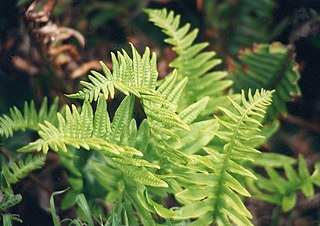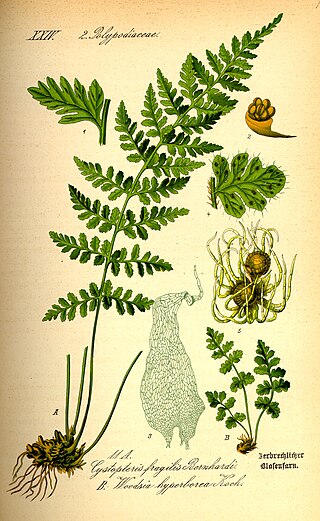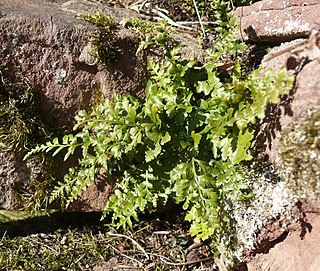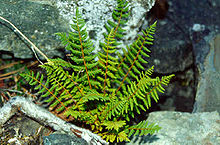
Thelypteridaceae is a family of about 900 species of ferns in the order Polypodiales. In the Pteridophyte Phylogeny Group classification of 2016, it is placed in the suborder Aspleniineae. Alternatively, the family may be submerged in a very broadly defined family Aspleniaceae as the subfamily Thelypteridoideae.

The Aspleniaceae (spleenworts) are a family of ferns, included in the order Polypodiales. The composition and classification of the family have been subject to considerable changes. In particular, there is a narrow circumscription, Aspleniaceae s.s., in which the family contains only two genera, and a very broad one, Aspleniaceae s.l., in which the family includes 10 other families kept separate in the narrow circumscription, with the Aspleniaceae s.s. being reduced to the subfamily Asplenioideae. The family has a worldwide distribution, with many species in both temperate and tropical areas. Elongated unpaired sori are an important characteristic of most members of the family.

The Dryopteridaceae are a family of leptosporangiate ferns in the order Polypodiales. They are known colloquially as the wood ferns. In the Pteridophyte Phylogeny Group classification of 2016 (PPG I), the family is placed in the suborder Polypodiineae. Alternatively, it may be treated as the subfamily Dryopteridoideae of a very broadly defined family Polypodiaceae sensu lato.

The order Polypodiales encompasses the major lineages of polypod ferns, which comprise more than 80% of today's fern species. They are found in many parts of the world including tropical, semitropical and temperate areas.

Blechnaceae is a family of ferns in the order Polypodiales, with a cosmopolitan distribution. Its status as a family and the number of genera included have both varied considerably. In the Pteridophyte Phylogeny Group classification of 2016, the family has 24 genera, and excludes genera placed in the separate family Onocleaceae. The family is divided into three subfamilies, including Blechnoideae s.s. Alternatively, the entire family may be treated as the subfamily Blechnoideae s.l. of a very broadly defined family Aspleniaceae, and include genera others place in Onocleaceae.

The Athyriaceae are a family of terrestrial ferns in the order Polypodiales. In the Pteridophyte Phylogeny Group classification of 2016 (PPG I), the family is placed in the suborder Aspleniineae, and includes two genera. Alternatively, it may be treated as the subfamily Athyrioideae of a very broadly defined family Aspleniaceae. The family has with a cosmopolitan distribution.

Onocleaceae is a small family of terrestrial ferns in the order Polypodiales. It is placed in the suborder Aspleniineae in the Pteridophyte Phylogeny Group classification of 2016. Alternatively, the family, along with Blechnaceae, may be placed in a very broadly defined family Aspleniaceae as the subfamily Blechnoideae. The family may contain from one to four genera, consisting of five species largely in north temperate climes. The four genera, Matteuccia, Onoclea, Onocleopsis and Pentarhizidium, may be included under the single genus Onoclea.

Woodsia is a genus of ferns in the family Woodsiaceae. Species of Woodsia are commonly known as cliff ferns. In the Pteridophyte Phylogeny Group classification of 2016 (PPG I), it was the only genus in the family Woodsiaceae. In 2020, Physematium was split off from Woodsia on the basis of molecular phylogenetic evidence. As of June 2023, Plants of the World Online continued to treat Physematium as a synonym of Woodsia.

The Lomariopsidaceae is a family of ferns with a largely tropical distribution. In the Pteridophyte Phylogeny Group classification of 2016 (PPG I), the family is placed in the suborder Polypodiineae of the order Polypodiales. Alternatively, it may be treated as the subfamily Lomariopsidoideae of a very broadly defined family Polypodiaceae sensu lato.

Aspleniineae is a suborder of ferns in the order Polypodiales. It is equivalent to the clade eupolypods II in earlier systems; it is also treated as a single very broadly defined family Aspleniaceae. The suborder generally corresponds with the order Blechnales as described by J. L. Reveal in 1993. Aspleniineae includes some important ferns, including Onoclea sensibilis, the sensitive fern, which grows as a virtual weed throughout much of its temperate North American range, and ferns of the genus Thelypteris, a genus that has shown remarkable speciation. It also includes one of the more common horticultural ferns, Matteuccia struthiopteris, the ostrich fern.

Doodia is a genus of ferns in the family Blechnaceae, subfamily Blechnoideae, in the suborder Aspleniineae. It is named after Samuel Doody (1656-1706), an English botanist. Distribution of the genus includes parts of Australia and New Zealand.

Homalosorus is a genus of fern with only one species, Homalosorus pycnocarpos. It may also be referred to by its older synonyms Athyrium pycnocarpon and Diplazium pycnocarpon. Commonly referred to as the narrow-leaved glade fern, narrow-leaved-spleenwort, or glade fern, it is endemic to eastern North America and typically grows in moist woodlands. Once classified in the family Athyriaceae due to its linear, often doubled sori, in the Pteridophyte Phylogeny Group classification of 2016, it is placed in the small family Diplaziopsidaceae, whose other three species are native to east Asia. Other sources place the genus in the subfamily Diplaziopsidoideae of a very broadly defined family Aspleniaceae, equivalent to the suborder Aspleniineae in PPG I.

Cystopteridaceae is a family of ferns in the order Polypodiales. In the Pteridophyte Phylogeny Group classification of 2016 (PPG I), the family is placed in the suborder Aspleniineae of the order Polypodiales, and includes three genera. Alternatively, it may be treated as the subfamily Cystopteridoideae of a very broadly defined family Aspleniaceae.

Polypodiineae is a suborder of ferns in the order Polypodiales. It is equivalent to the clade eupolypods I in earlier systems, and to the very broadly defined family Polypodiaceae in the classification of Christenhusz & Chase (2014). It probably diverged from the suborder Aspleniineae during the mid-Cretaceous. The divergence is supported by both molecular data and an often overlooked morphological characteristic which lies in the vasculature of the petiole. Most species that make up the suborder have three vascular bundles. The only exceptions are the grammitid ferns which have one, and the genus Hypodematium which has two. This differs from eupolypods II which mostly have two vascular bundles.
Hemidictyum is a genus of ferns with a single species, Hemidictyum marginatum, commonly known as the marginated half net fern. In the Pteridophyte Phylogeny Group classification of 2016, it is the only genus in the family Hemidictyaceae. Alternatively, the family, along with Aspleniaceae sensu stricto, may be placed in a much more broadly defined family Aspleniaceae as the subfamily Asplenioideae.

Diplaziopsidaceae is a family of ferns in the order Polypodiales. In the Pteridophyte Phylogeny Group classification of 2016 (PPG I), the family is placed in the suborder Aspleniineae, and includes two genera. Alternatively, it may be treated as the subfamily Diplaziopsidoideae of a very broadly defined family Aspleniaceae.
Rhachidosorus is a genus of ferns in the order Polypodiales. It is the only genus in the family Rhachidosoraceae in the Pteridophyte Phylogeny Group classification of 2016. Alternatively, the genus may be placed in the subfamily Rhachidosoroideae of a more broadly defined family Aspleniaceae, the family placement used in Plants of the World Online as of November 2019.
The Pteridophyte Phylogeny Group (PPG) is an informal international group of systematic botanists who collaborate to establish a consensus on the classification of pteridophytes that reflects knowledge about plant relationships discovered through phylogenetic studies. In 2016, the group published a classification for extant pteridophytes, termed "PPG I". The paper had 94 authors.

Physematium is a genus of ferns in the family Woodsiaceae. It was treated as a synonym of Woodsia until 2020 when a molecular phylogenetic study showed its distinctiveness. As of June 2023, Plants of the World Online continued to treat the genus as a synonym of Woodsia.

















